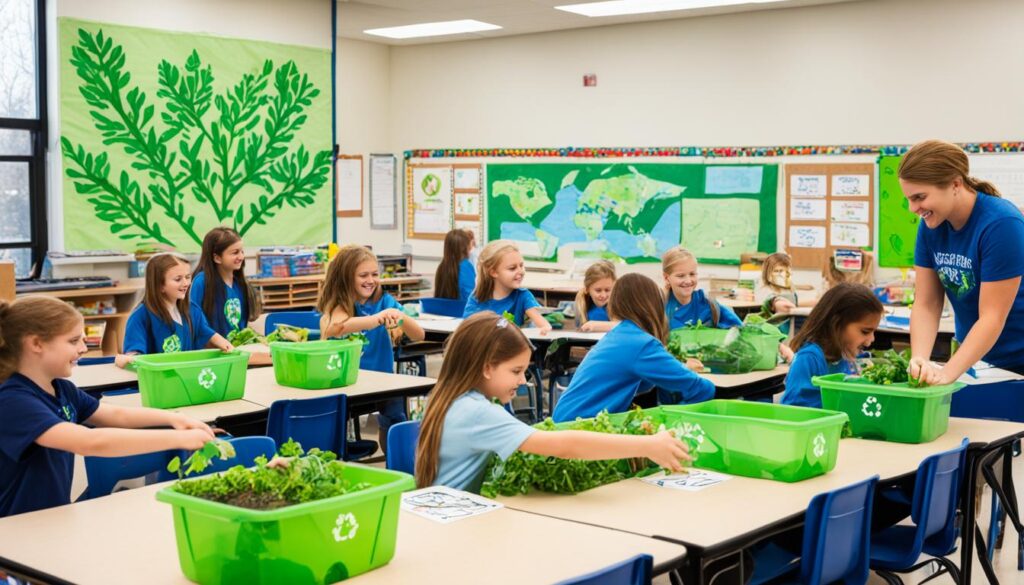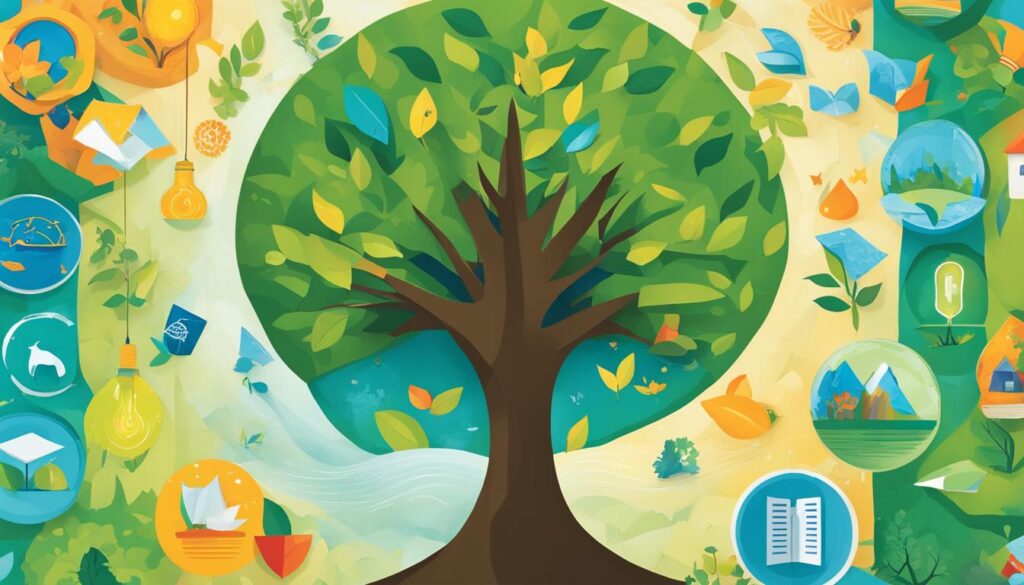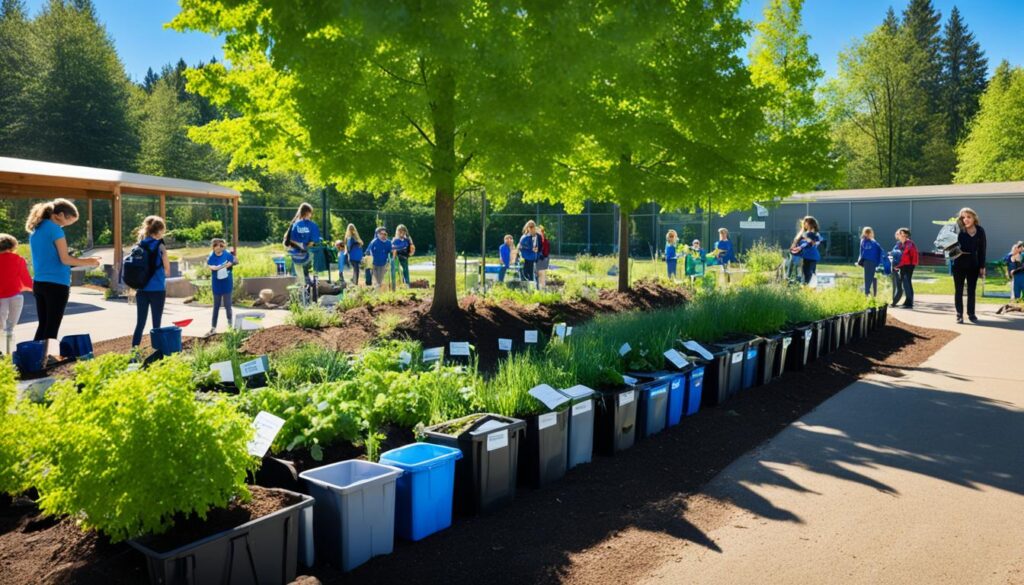Welcome to our article on the important role that schools play in cultivating environmental awareness. In today’s world, it is essential to educate students about the importance of environmental conservation and inspire them to become eco-conscious individuals. Through dedicated environmental awareness education, schools can shape a generation that is passionate about protecting our planet.
Environmental awareness education goes beyond simply learning about the environment. It involves developing a deep understanding of the impact of our actions on the natural surroundings. Students explore topics such as climate change, deforestation, pollution, and water scarcity, gaining knowledge that empowers them to make sustainable choices.
This article will delve into the necessity of incorporating eco-conscious learning into school curriculums. We will discuss the importance of starting environmental education early, how schools can respond to environmental challenges, and the impact of initiatives like the Eco-Schools program. We will also explore the role of educators in serving as eco-friendly role models and the importance of community involvement in sustainability education.
Join us on this journey as we uncover the power of environmental awareness education in schools and its ability to shape a sustainable future for generations to come.
Key Takeaways:
- Environmental awareness education plays a crucial role in cultivating eco-conscious individuals.
- Students learn about the impact of actions on the environment, such as climate change and pollution.
- Integrating eco-friendly education into school curriculums helps provide a well-rounded understanding of environmental issues.
- Starting environmental education at a young age has a lasting impact on students’ attitudes and behaviors.
- The Eco-Schools Initiative promotes environmental literacy and provides strategies for green learning.
Understanding Environmental Awareness Education
Environmental awareness education is a vital component of fostering a sustainable future. It involves developing an understanding of our natural surroundings and the impact of our actions on the environment. Through education, students learn about various environmental challenges such as climate change, deforestation, pollution, and water scarcity, gaining the knowledge necessary to make informed decisions and take action for conservation.
By raising awareness about these issues, environmental education encourages individuals to reflect on their own behaviors and consider the consequences of their actions. It promotes a sense of responsibility and empowers students to become advocates for positive change in their communities and beyond.
Effective environmental education programs inspire students to appreciate the interconnectedness of their actions and the environment. They provide opportunities for experiential learning, allowing students to engage directly with nature, observe its complexities, and develop a deep connection to the natural world.
Through environmental awareness education, students gain the knowledge, skills, and attitudes needed to address pressing environmental challenges. It equips them with the tools to contribute to solutions and become stewards of the environment, ensuring a sustainable future for generations to come.
The Necessity of Eco-Conscious Learning in Schools
Eco-conscious learning plays a crucial role in cultivating environmental awareness among students. By integrating eco-friendly education into school curriculums, we can create comprehensive environmental education programs that have a lasting impact on young minds. Starting early is key to instilling a sense of responsibility and inspiring future generations to become environmentally-conscious individuals.
Integrating Eco-Friendly Education in Curriculums
To create a well-rounded understanding of environmental issues, it is important to include eco-friendly topics and projects in various subjects. By incorporating these themes into subjects such as science, social studies, and even art, students can develop a holistic view of the environment and their role in preserving it. This integration allows for a seamless and engaging learning experience that encourages students to think critically about their impact on the planet.
The Importance of Starting Early: The Impact on Young Minds
Starting environmental education at a young age can have a profound and lasting influence on students’ attitudes and behaviors towards the environment. Young minds are receptive and curious, making them more open to learning about sustainability and conservation. By introducing eco-conscious learning early in their academic journey, we can nurture a generation of environmentally-conscious individuals who are equipped to tackle the complex environmental challenges of the future.

| Benefits of Eco-Conscious Learning in Schools |
|---|
| 1. Fosters a sense of responsibility towards the environment |
| 2. Encourages critical thinking and problem-solving skills |
| 3. Promotes sustainable behaviors and lifestyles |
| 4. Develops a deeper connection and appreciation for nature |
| 5. Empowers students to become environmental advocates and agents of change |
Eco-conscious learning in schools not only equips students with the knowledge to address environmental challenges but also empowers them to become active participants in creating a sustainable future. By integrating eco-friendly education into curriculums and starting early, we can shape young minds to become responsible stewards of the environment.
Environmental Challenges and Education’s Response
How Climate Change and Pollution Drive Curriculum Change
Climate change and pollution are pressing environmental challenges that demand a swift response from educational institutions. Schools are recognizing the need to adapt their curriculums to address these issues effectively. By incorporating climate change and pollution topics into their educational programs, schools play a crucial role in raising awareness and equipping students with the knowledge and skills to tackle these challenges head-on.
The curriculum change is driven by the understanding that climate change and pollution have far-reaching consequences for the planet and future generations. Students need to comprehend the causes and effects of these environmental issues to take informed action. By integrating climate change and pollution into various subjects, schools create opportunities for in-depth exploration and interdisciplinary learning.
In science classes, students learn about the greenhouse effect, the impacts of rising temperatures, and the importance of reducing carbon emissions. Social studies curriculums shed light on the socio-economic aspects of climate change and how it disproportionately affects vulnerable communities. English literature classes can discuss environmental justice through relevant texts, fostering critical thinking and empathy.
By infusing climate change and pollution education into the entire curriculum, schools emphasize the interconnectedness of environmental issues, promoting a comprehensive understanding of their complexities.
Responding to Deforestation and Water Scarcity Through Education
In addition to climate change and pollution, addressing deforestation and water scarcity is crucial for a sustainable future. Educational programs play a vital role in raising awareness of these challenges and inspiring proactive measures.
Through geography classes, students learn about the devastating impact of deforestation on biodiversity, local communities, and global climate regulation. They explore sustainable land management practices and the importance of forest conservation. By examining real-life case studies, students gain insights into the interconnectedness of deforestation and environmental stability.
“Deforestation is not simply the removal of trees, but the dismantling of an intricate ecological system that sustains life on our planet.” – Jane Goodall
Water scarcity education focuses on understanding the importance of water conservation and sustainable water management. Students learn about the causes of water scarcity, such as overconsumption and pollution, and explore innovative solutions like rainwater harvesting and efficient irrigation techniques. By nurturing a sense of responsibility for water resources, schools empower students to make conscious choices to mitigate water scarcity.
By addressing deforestation and water scarcity through education, schools equip students with the knowledge and skills needed to protect vital natural resources and establish a more sustainable future.
The Eco-Schools Initiative: A Model for Success
The Eco-Schools Initiative is a global program that promotes environmental literacy and encourages schools to adopt sustainable practices. Through this initiative, schools become agents of change by integrating environmental education programs into their curriculums and engaging students in green learning experiences.
A Global Reach: The Impact of Eco-Schools on Environmental Literacy
The Eco-Schools Initiative has had a significant impact on environmental literacy worldwide. By actively involving students and teachers in practical environmental projects, Eco-Schools have successfully enhanced students’ understanding of environmental issues and their capacity to address them. This hands-on approach empowers students to become environmental stewards, fostering a sense of responsibility and equipping them with the knowledge and skills needed to take environmental action.

Key Strategies of Eco-Schools for Promoting Green Learning
Eco-Schools employ key strategies to promote green learning and create a culture of sustainability within educational institutions:
- Implementing an environmental management system: Eco-Schools encourage schools to establish procedures and policies that address sustainability issues, allowing for continuous improvement.
- Conducting environmental audits: Schools evaluate their environmental performance, identifying areas for improvement and setting goals for sustainability.
- Engaging the entire school community: Eco-Schools involve students, teachers, staff, and parents in environmental projects and initiatives, fostering collaboration and collective responsibility.
- Integrating environmental education into the curriculum: Eco-Schools integrate environmental topics and hands-on learning experiences into various subjects, ensuring that environmental literacy becomes an integral part of students’ education.
- Promoting student-led initiatives: Eco-Schools empower students to take the lead in planning and implementing environmental projects, encouraging creativity, innovation, and a sense of ownership.
These strategies not only provide students with the knowledge and skills needed to address environmental challenges but also instill a passion for sustainability and a lifelong commitment to protecting the planet.
Promoting Sustainable Education Initiatives in Schools
Schools have a significant role to play in promoting sustainable education initiatives. By embracing eco-friendly practices and teaching students about sustainable living, schools can instill a culture of sustainability that prepares future generations to be responsible stewards of the environment.
There are several initiatives that schools can adopt to create a sustainable educational environment:
- Implementing energy-saving measures: Schools can reduce their carbon footprint by implementing energy-saving techniques such as using energy-efficient appliances, installing solar panels, and optimizing heating and cooling systems.
- Promoting waste reduction and recycling: Schools can educate students about the importance of waste reduction and recycling. By setting up recycling programs, composting initiatives, and encouraging waste-free lunches, schools can teach students how to minimize their impact on the environment.
- Incorporating sustainable practices into daily routines: Schools can integrate sustainable practices into daily routines, such as encouraging the use of eco-friendly stationery, choosing sustainable materials for school projects, and promoting water conservation.

By leading by example, schools can inspire students to adopt eco-friendly initiatives in their own lives and become agents of change in their communities. When students witness sustainable practices in action, they are more likely to embrace sustainable behaviors, creating a ripple effect that extends beyond the school environment.
Leading by Example: Educators as Eco-Friendly Role Models
Educators play a critical role in shaping the environmental consciousness of students. By incorporating practical environmental actions into their teaching, they can serve as eco-friendly role models and inspire the next generation to make a positive impact on the planet.
Turning everyday activities, such as waste reduction, energy conservation, and responsible consumption, into teachable moments can create lasting impressions on students’ minds. Educators who lead by example demonstrate the importance of taking practical steps towards environmental conservation.

Inspiring stories abound of teachers who have gone above and beyond to promote environmental conservation. These dedicated educators have implemented innovative projects, such as creating sustainable gardens, organizing community clean-up campaigns, and initiating recycling programs within their schools. Their unwavering commitment to conservation efforts serves as an inspiration to both students and fellow teachers.
By sharing such inspirational stories and highlighting the impact of their conservation efforts, educators can foster a sense of environmental responsibility and inspire students to take action in their own lives.
Environmental Education Programs: Beyond the Classroom
Environmental education plays a crucial role in shaping eco-conscious individuals. However, it shouldn’t be limited to the classroom. To truly cultivate ecological citizenship education, students need to be involved in environmental initiatives beyond the school walls.
Encouraging Ecological Citizenship Education at Home and Community
Encouraging ecological citizenship education at home and in the community allows students to apply their environmental knowledge and skills in real-life situations. By engaging students in sustainable practices within their own households and local neighborhoods, schools can foster a sense of responsibility and empowerment.
Through environmental education programs, students can learn about resource conservation, waste reduction, and sustainable living practices. This knowledge can then be shared with their families, inspiring positive changes that extend beyond the school environment.
Involving Students in Climate Change Awareness Initiatives
Involving students in climate change awareness initiatives is essential for equipping them with the knowledge and skills needed to address this global challenge. Schools can facilitate student-led projects, such as organizing climate action events, participating in community clean-ups, and advocating for sustainable policies.
By actively engaging in climate change awareness initiatives, students become environmental advocates and change agents. They develop a deeper understanding of the issues surrounding climate change and gain the confidence to take meaningful actions in their communities.
Nature Education Through School-Led Conservation Programs
Schools have a unique opportunity to foster nature education through their conservation programs. By offering hands-on experiences, these programs provide students with valuable opportunities to connect with the natural world and learn about the importance of conservation. Incorporating outdoor learning, nature exploration, and wildlife conservation, school-led programs offer numerous benefits for students and the environment.
Resources and Activities for Enhancing Environmental Literacy
Schools play a vital role in enhancing environmental literacy among students. By providing access to a range of resources and activities, educators can engage students and empower them to become environmentally conscious individuals. This section will explore various examples of projects and resources that promote environmental literacy, including recycling initiatives, sustainability education programs, and interactive tools for climate change education.
From Recycling Projects to Sustainability Education: Engaging Students
Recycling projects are an effective way to engage students in hands-on learning while promoting sustainability. By creating recycling programs within schools, students learn about the importance of waste reduction and the impact of their actions on the environment. These projects encourage critical thinking, problem-solving, and collaboration among students, fostering a sense of responsibility towards environmental conservation.
Sustainability education programs provide comprehensive knowledge about environmental issues, sustainable practices, and the importance of preserving natural resources. These programs often incorporate multidisciplinary approaches, integrating science, social studies, and practical skills to cultivate well-rounded environmental literacy. By engaging students in discussions, workshops, and practical activities, these programs inspire a deeper understanding and commitment to sustainable lifestyles.
Furthermore, incorporating interactive tools for climate change education can significantly enhance students’ understanding of this critical issue. Interactive simulations, virtual field trips, and online resources allow students to explore the causes and effects of climate change in an engaging and immersive way. These tools foster curiosity, critical thinking, and active participation, empowering students to take action in mitigating and adapting to climate change.
Interactive Climate Change Education Tools
Interactive climate change education tools provide students with dynamic learning experiences that promote environmental awareness. These tools enable students to visualize complex concepts, understand the interconnectedness of environmental systems, and explore real-world scenarios. Through interactive simulations, students can manipulate variables, observe cause-and-effect relationships, and develop solutions to address climate change challenges.
Beyond the classroom, online platforms, and educational websites offer a wealth of interactive resources for climate change education. These resources include interactive videos, infographics, and games that engage students in educational and entertaining ways. Through these interactive tools, students can deepen their understanding of climate change, expand their knowledge of sustainability practices, and develop the skills necessary to tackle environmental challenges.
| Resource/Activity | Description |
|---|---|
| Recycling Projects | Hands-on projects that encourage waste reduction and promote recycling practices within schools. |
| Sustainability Education Programs | Structured programs that provide comprehensive knowledge about environmental issues, sustainable practices, and conservation strategies. |
| Interactive Climate Change Education Tools | Online platforms, simulations, and interactive resources that engage students in learning about climate change and its impacts. |
Table: Examples of Resources and Activities for Enhancing Environmental Literacy
By incorporating these resources and activities, schools can create an engaging and enriching learning environment that fosters environmental literacy. Through recycling projects, sustainability education programs, and interactive tools for climate change education, students develop the knowledge, skills, and attitudes necessary to become responsible stewards of the environment.
Partnerships and Community Involvement in School Sustainability Education
Partnerships and community involvement play a vital role in the success of school sustainability education. By collaborating with local organizations, businesses, and community members, schools can enhance their sustainability education efforts and create a network of support and resources.
Partnering with organizations that share a commitment to environmental conservation provides schools with access to expertise, funding, and educational materials. For example, schools can collaborate with nonprofits focused on sustainability, such as the Australian Conservation Foundation, to develop tailored educational programs and initiatives.
Involving local businesses in sustainability education programs offers unique opportunities for students to learn about eco-friendly practices in real-world settings. Schools can organize field trips to businesses that prioritize sustainability, such as renewable energy companies or organic farms, allowing students to see sustainable practices in action.
Engaging community members in school sustainability education fosters a sense of collective responsibility and ownership. Schools can organize community events, such as tree planting activities or recycling drives, where students, parents, and community members come together to make a positive impact.
By forging partnerships and involving the community, schools can strengthen their sustainability education efforts. These collaborations provide students with valuable experiences, resources, and role models, empowering them to become environmentally conscious citizens.
Conclusion
In conclusion, eco-friendly initiatives in education play a vital role in shaping a sustainable future and creating environmentally-conscious citizens. Throughout this article, we have explored the importance of environmental awareness education in schools and how it can cultivate a sense of responsibility towards the environment.
By integrating eco-friendly topics and projects into school curriculums, we can provide students with a comprehensive understanding of environmental issues. Starting environmental education at a young age has a lasting impact on students’ attitudes and behaviors, empowering them to become environmental stewards.
Through collaborations with local organizations and community involvement, schools can enhance sustainability education, creating a network of support and resources. By incorporating practical environmental actions into teaching and providing hands-on experiences through nature education and conservation programs, we can foster a deeper connection to the natural world and inspire students to take action for conservation.
As we move forward, it is crucial to continue promoting eco-friendly initiatives in education. By doing so, we can empower the new generation to embrace environmental stewardship, creating a sustainable future where individuals prioritize the well-being of the planet. Together, let us strive to build a greener, healthier world through education and action.
FAQ
What is environmental awareness education?
Environmental awareness education involves developing an understanding of the natural surroundings and how our actions impact the environment. Students learn about the various environmental challenges such as climate change, deforestation, pollution, and water scarcity. It is essential to educate students about these issues to foster a sense of responsibility and inspire them to take action for conservation.
How can eco-conscious learning be integrated into school curriculums?
Eco-conscious learning should be integrated into school curriculums to create a comprehensive environmental education program. It is important to include eco-friendly topics and projects in various subjects to provide students with a well-rounded understanding of environmental issues.
Why is it important to start environmental education at a young age?
Starting environmental education at a young age can have a lasting impact on students’ attitudes and behaviors towards the environment. By introducing eco-friendly practices and raising awareness about environmental issues early on, we can inspire the next generation to become environmentally-conscious citizens.
How are schools adapting their educational programs to address environmental challenges?
Schools are adapting their educational programs by raising awareness about the causes and effects of environmental challenges such as climate change, pollution, deforestation, and water scarcity. They are also teaching students how they can contribute to the solutions and make a positive impact on the environment.
What is the Eco-Schools Initiative?
The Eco-Schools Initiative is a global program that promotes environmental literacy and encourages schools to adopt sustainable practices. It focuses on creating a culture of sustainability by providing resources and guidance to schools, students, and communities.
How can schools promote sustainable education initiatives?
Schools can promote sustainable education initiatives by implementing energy-saving measures, promoting waste reduction and recycling, and incorporating sustainable practices into daily routines. They can also collaborate with local organizations, businesses, and community members to enhance sustainability education in schools.
How can educators serve as eco-friendly role models in promoting environmental conservation?
Educators can serve as eco-friendly role models by incorporating real-life examples of sustainable practices into teaching. This includes waste reduction, energy conservation, and responsible consumption. By incorporating these practices and sharing their own experiences, educators can inspire students to become environmentally-conscious individuals.
How can schools involve students in environmental initiatives at home and in their communities?
Schools can involve students in environmental initiatives by encouraging eco-friendly practices at home and engaging them in community projects. This fosters ecological citizenship education, where students take responsibility for the environment and become active participants in addressing environmental challenges.
What are the benefits of school-led conservation programs?
School-led conservation programs provide hands-on experiences for students, promoting nature education, outdoor learning, and wildlife conservation. These programs help students develop a connection to the natural world and a deeper understanding of conservation principles.
What resources and activities can enhance environmental literacy in schools?
Resources and activities such as recycling initiatives, sustainability education programs, and interactive climate change education tools can enhance environmental literacy in schools. Hands-on learning and interactive experiences play a crucial role in fostering environmental awareness among students.
Why is community involvement important for school sustainability education?
Community involvement is crucial for the success of school sustainability education. By collaborating with local organizations, businesses, and community members, schools can access additional resources and create a network of support to promote environmental awareness and sustainability.
Source Links
- https://www.gvi.co.uk/blog/how-to-cultivate-environmental-awareness-in-schools/
- https://www.vega.edu.in/vega-blog/child-development/the-role-of-schools-in-promoting-environmental-awareness/
- https://greenlivingguy.com/2020/12/how-to-cultivate-environmental-awareness-in-schools/

